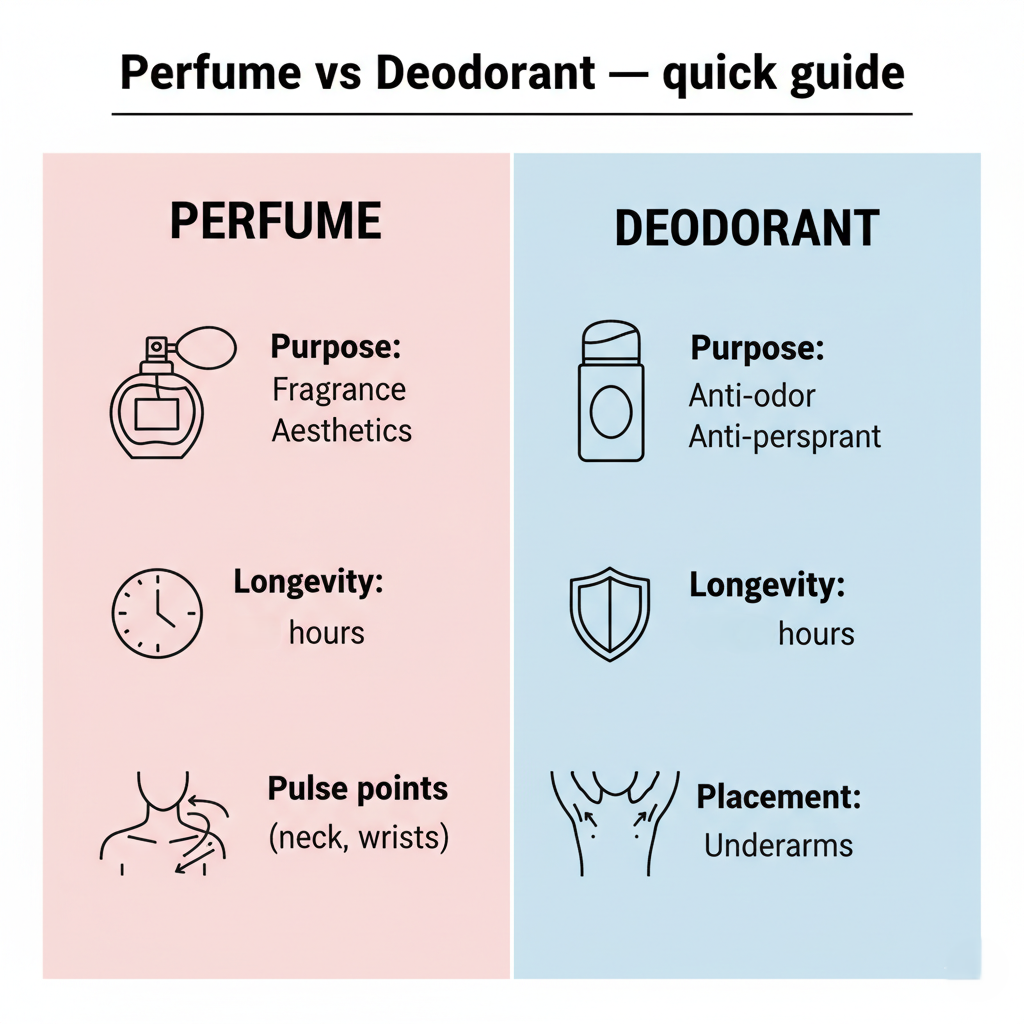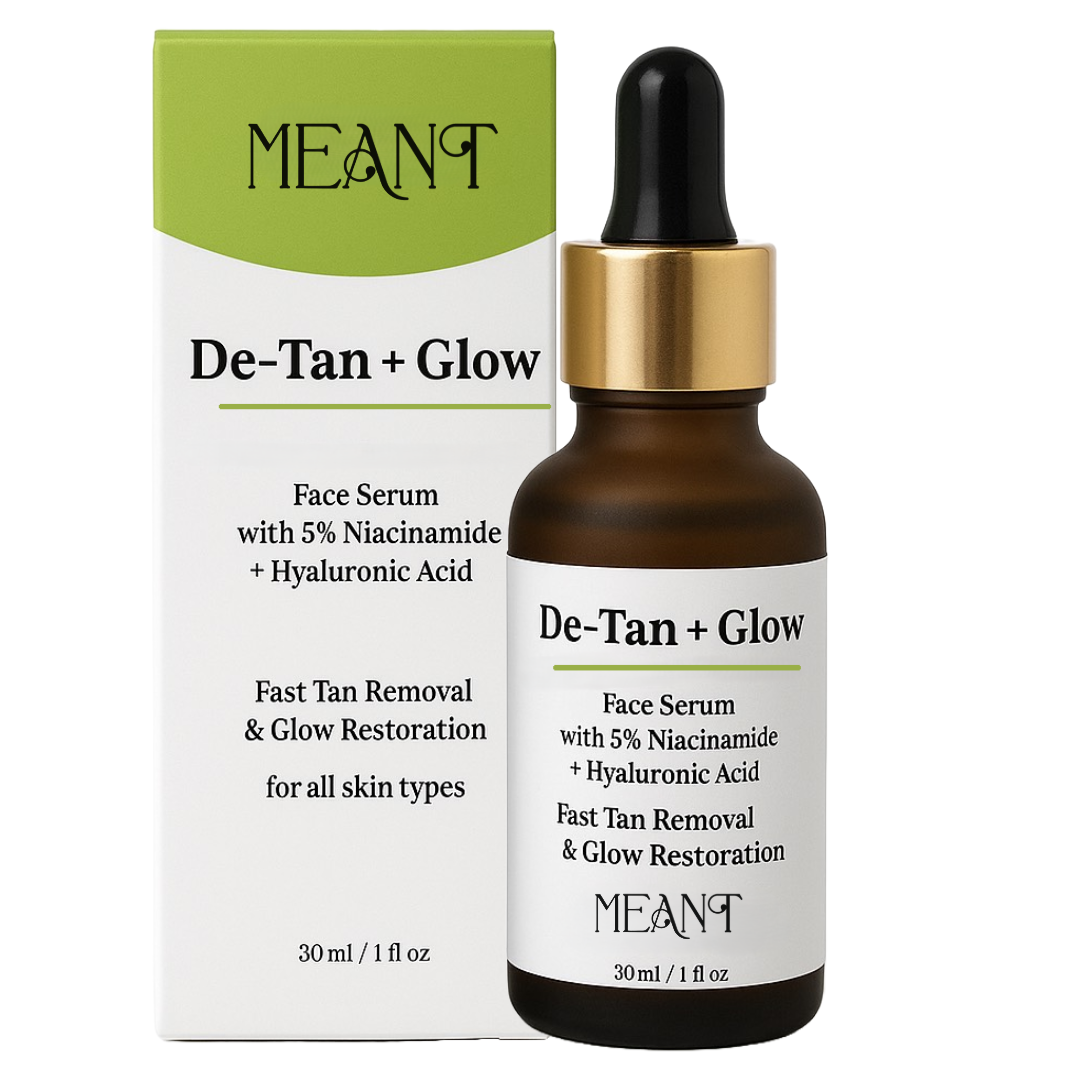
Perfume vs Deodorant: Key Differences, When to Use Which & How to Layer
Share
TL; DR
Perfume (EDP/Parfum) is formulated to give your whole body a curated fragrance profile with higher fragrance-oil concentration and longer longevity; deodorant is formulated primarily to neutralize or mask underarm odor and sometimes control sweat. They serve different roles, use deodorant for odor control and perfume/EDP for scent expression. For best results, layer smartly (clean skin → deo if needed → pulse-point perfume). MEANT is launching its first Signature EDP line for men & women very soon — perfect timing to shop a lasting signature scent.
Perfume vs Deodorant
Many shoppers confuse perfume and deodorant because both smell nice — but they are made for different jobs. This guide breaks down the scientific and practical differences (concentration, purpose, ingredients, longevity and how to layer them) so you can choose what’s right for your routine — and choose a signature scent that truly lasts. Plus: MEANT is preparing its first Signature EDP collection for men and women, launching in about 15–20 days — perfect if you want a long-lasting, refined fragrance for day-to-night wear.
What is perfume?
Perfume is a fragrance product designed primarily to deliver a complex scent experience — top, heart and base notes — across the skin and clothing. Perfumes come in different concentrations: parfum (extrait), eau de parfum (EDP), eau de toilette (EDT), eau de cologne and eau fraiche. Higher concentration = more fragrance oil = longer lasting and stronger projection. For example, EDP typically contains around 15–20% fragrance oils, while parfum/extrait is significantly more concentrated.
Why that matters: concentration defines lasting power and how the scent evolves on your skin.
What is deodorant?
Deodorant is formulated to neutralize or mask underarm odor caused by bacterial breakdown of sweat; many deodorants also include antimicrobial ingredients, masking fragrance, and sometimes antiperspirant actives (aluminum compounds) when combined as “antiperspirant-deodorant.” Deodorants prioritize odor control and skin-friendly application rather than complex fragrance structure.
Why that matters: deodorant controls odor at the source (underarms). Perfume is about expression, not odor-control.
Key differences at-a-glance
- Primary purpose: Perfume = fragrance/identity; Deodorant = odor control (sometimes sweat control, if labelled antiperspirant).
- Fragrance concentration: Perfume (EDP/Parfum) far higher than deodorant/body spray.
- Longevity: Perfumes (EDP/parfum) last longer — several hours to all day — while deodorants typically last shorter and may need reapplication. Typical ranges differ by product formulation.
- Application & placement: Perfume → pulse points (wrists, neck); Deodorant → underarms (or body sprays for all-over).
- Ingredients: Perfume uses concentrated fragrance oils + solvents; deodorant includes odor-neutralizers, antimicrobials, sometimes antiperspirants, plus fragrance.
How long does each last? (real-world ranges)
- Parfum / Extrait: longest (often 8+ hours depending on formula).
- Eau de Parfum (EDP): commonly 4–8+ hours (15–20% oils).
- Eau de Toilette (EDT): 2–4 hours (lighter, 5–15% oils).
- Deodorant / body sprays: widely variable — many last 4–8 hours for odor control; scent projection is lighter and shorter than EDPs.
Can deodorant replace perfume?
Short answer: no — deodorant helps control underarm smell and provides a light, usually singular scent. Perfume creates a multi-layered scent profile designed to evolve over hours. Many people use both: deodorant for odor control + perfume/EDP for identity and scent projection.
How to layer deodorant and perfume (pro tips)
- Start from clean skin. Smells last best when skin is freshly washed.
- Use deodorant under arms (unless it has a strong conflicting scent). Choose unscented or lightly scented deodorant if you plan to wear perfume.
- Apply EDP to pulse points (inner wrists, base of throat, behind ear). Don’t rub wrists together — it bruises top notes.
- Lightly mist clothing if you want longevity (test first — some perfumes stain).
- Less is more. A concentrated EDP needs fewer sprays.
- Test combinations. Skin chemistry affects how a perfume smells — test before commitment. (This is why many brands offer discovery vials or sample programs). Reddit.com
Ingredients & safety notes
- Perfumes contain fragrance oils, solvents (usually alcohol) and small stabilizers. Fragrance oils themselves are blends of naturals and synthetics.
- Deodorants may include antimicrobials, odor absorbers, fragrances, and antiperspirant actives (if labelled). Some users report skin sensitivity to certain deodorant ingredients — patch-test if prone to reactions. Recent reviews and studies have examined adverse effects linked to specific formulations. PubMed Central
Choosing the right product for the occasion
- Daily/office wear: light EDT or EDP, paired with deodorant for odor control.
- Long events / evening: parfum or EDP for lasting projection.
- Gym / intense activity: antiperspirant-deodorant; reserve perfume for after shower.
- Sensitive skin: fragrance-free or low-fragrance deodorants; patch test perfumes.
MEANT note
If you’re hunting for a signature scent that performs like an EDP, keep an eye on MEANT’s first-ever Signature EDP line for men & women, launching in ~15–20 days — crafted to offer balanced longevity and refined projection for day-to-night wear (perfect for layering with deodorant). Use sample vials to test on your skin tone and chemistry before buying full bottles.
FAQs
Q1: Can deodorant replace perfume?
A: No. Deodorants are formulated to control or mask underarm odor; perfumes (EDP/parfum) are blended to create a multilayer scent that evolves through top/heart/base notes. For a signature scent, choose an EDP or parfum.
Q2: Will deodorant clash with my perfume?
A: It can. Pick an unscented or lightly scented deodorant if you plan to wear a distinct perfume or choose deodorant and perfume within the same scent family (citrus with citrus, woody with woody) to reduce clashes. Test before you commit.
Q3: How should I layer deodorant and perfume?
A: Clean skin → deodorant (underarms) → EDP on pulse points. Avoid spraying perfume directly into underarms. For longevity, lightly mist clothing but test for staining.
Q4: What’s the best perfume concentration for everyday wear?
A: Many prefer Eau de Parfum (EDP) for its balance of longevity and projection (around 15–20% oils). EDTs are lighter for shorter wear; parfum/extrait is richer and longer lasting for evening or formal wear.
Q5: Are deodorants safe?
A: Most are safe for regular use, but some people may react to specific ingredients. If you have sensitive skin, choose fragrance-free options and patch-test new products. Recent studies examine potential irritant effects for certain formulations.
People also ask
What is the main difference between perfume and deodorant?
The biggest difference is their purpose: perfume (EDP, parfum, EDT) is designed to provide a long-lasting, multi-layered fragrance profile, while deodorant is formulated to neutralize underarm odor and sometimes control sweat. Perfume = identity & expression; deodorant = hygiene & freshness.
Does deodorant ruin perfume?
Not usually, but a strongly scented deodorant can clash with your perfume notes. To avoid this, use an unscented or lightly scented deodorant if you plan to wear perfume, then apply your fragrance on pulse points (not underarms).
Can I use perfume as deodorant?
No — perfume does not contain antibacterial or odor-neutralizing agents, so it won’t stop underarm odor. Perfume is meant for pulse points, clothing or hair, not underarms. For best results, use deodorant for odor control and perfume for fragrance.
How long does Eau de Parfum last compared to deodorant?
- Eau de Parfum (15–20% fragrance oils): usually 8–11+ hours, depending on skin and environment.
-
Deodorant: controls odor for 3–6 hours but offers much lighter scent projection.
Perfume = longevity + scent profile. Deodorant = freshness + odor control.
Should I apply deodorant before or after perfume?
Always apply deodorant first, on clean underarms, then layer perfume on pulse points. This prevents odor while letting the perfume project naturally without interference.

